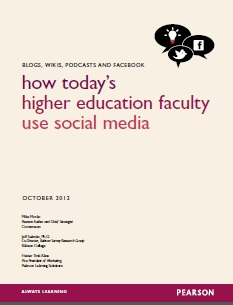Moran Seaman et al 2012
Blogs, Wikis, Podcasts And Facebook - how today’s higher education faculty use social media
1. Références
- Référence complète APA : Moran, M., Seaman, J., & Tinti-Kane, H. (2012). Blogs, Wikis, Podcasts And Facebook - how today’s higher education faculty use social media. Pearson.
- Auteur(s) : Mike Moran, Jeff Seaman, Hester Tinti-Kane
2. Copies
- Copie électronique en ligne : http://www.pearsonlearningsolutions.com/higher-education/social-media-survey.php
- Copie électronique locale : Moran Seaman et al 2012.pdf
- Copie physique CP : oui - PRAC-TICE - EU
- Copie physique en bibliothèque : /
3. Mots-clés
4. Résumé exécutif
"Faculty are very aware of social media and considerable numbers of them use it regularly in their personal lives. Levels of adoption for professional and teaching purposes lag behind that for personal use. Facebook is the most-visited social media site for personal use, with over one-half of faculty visiting at least monthly. Daily use of Facebook exceeds the daily, weekly, and monthly use of any other site by faculty for personal purposes. Personal use of Twitter among faculty is generally low, well behind use of podcasts, LinkedIn, and blogs and wikis.
Young faculty members use social media at rates much higher than the rates for older faculty—a pattern that holds true for personal use, professional use, and use in teaching. Virtually every measure of adoption and use shows that the youngest faculty are in the lead and the oldest lag behind. Faculty are selective about their choice of social media sites, matching different sites to their different needs; the sites they visit most often for personal use (Facebook), professional use (LinkedIn), and for use for in teaching (Blogs and Wikis) are all different.
The use of social media among faculty is fluid and evolving. The mix of sites being used is changing over time— in 2011 Facebook was the most visited site for faculty professional purposes; by 2012 this has been replaced by LinkedIn. Use of Facebook for professional purposes dropped, while the usage of LinkedIn increased over the one-year period.
One area where adoption is almost universal is in the use of video for classes. Whether it is used in a class session or assigned for viewing outside of class, faculty are enthusiastic adopters of video. They mostly rely on their own online searching to find appropriate videos, but select from a number of different sources. Online video sources are the most commonly used, but video from educational publishers is also popular. Faculty continue to see significant barriers to widespread adoption of social media for teaching. The top two concerns remain privacy and the integrity of student submissions. The need or desire to separate course and personal accounts was also cited by a large number of faculty as an important barrier. The degree of concern with all measured barriers is decreasing over time, with the largest decrease seen for the issue of the amount of time that it takes. Faculty in every subgroup had far less concern with the time required by social media in teaching in 2012 than they did the previous year."
5. Table des matières (facultatif)
- Faculty personal use of social media of social media............................................................................................ 5
- Faculty professional use of social media..................................................................................................8
- Faulty teaching use of social media....................................................................................................... 14
- Faculty use of video in teaching............................................................................................................. 20
- Barriers to faculty use of social media.................................................................................................. 23
6. Résumé personnel (facultatif)
